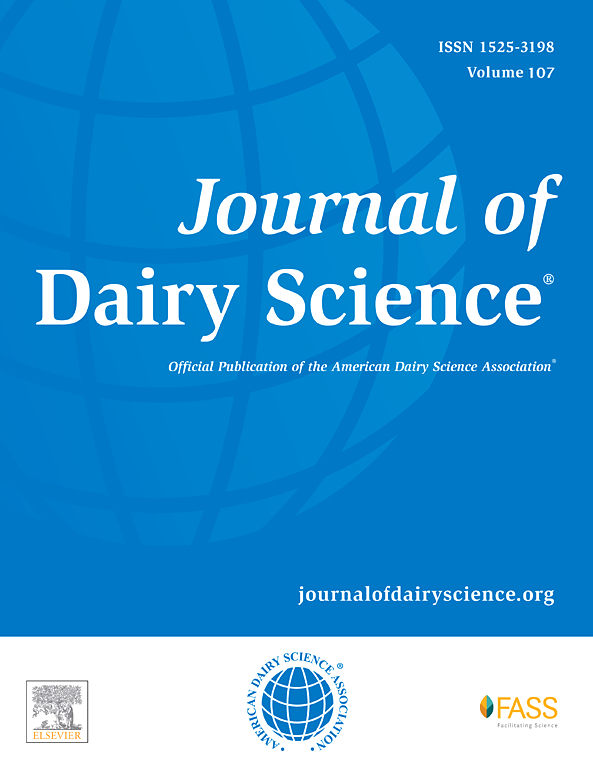Daily rhythms of glucose, insulin, and nonesterified fatty acid responses to an intravenous glucose tolerance test in dairy cows
IF 3.7
1区 农林科学
Q1 AGRICULTURE, DAIRY & ANIMAL SCIENCE
引用次数: 0
Abstract
In nonruminant species, glucose tolerance and insulin sensitivity are known to be regulated by circadian rhythms, which are repeating ∼24-h cycles that govern many aspects of behavior, physiology, and metabolism. However, it is unknown if these rhythms exist in dairy cows. Our objective was to determine the fit of a daily rhythm of glucose, insulin, and nonesterified fatty acid (NEFA) clearance rates independent of daily patterns of nutrient intake. To accomplish our objective, 12 multiparous lactating Holstein cows were enrolled in a within-subject design conducted over 2 experimental periods (n = 6/period). Within each period, cows were subjected to intravenous glucose tolerance tests (IVGTT) at 4 timepoints, representing different times of the day (0300, 0900, 1500, and 2100 h). The 0900 and 2100 h IVGTT were performed 36 h apart, followed by a 7-d washout, and then the 1500 and 0300 h IVGTT were performed 36 h apart. Cows were fed 12 times/d at 2-h intervals beginning 24 h before the first IVGTT in each set until the second IVGTT in each set to stabilize feed intake across the day, with 1 time/d feeding occurring during the washout period. For each IVGTT, 250 g of glucose was infused as a 50% (wt/vol) d-glucose solution via a jugular catheter and blood was collected at −15, −5, immediately before, 0, 5, 10, 15, 20, 30, 45, 60, 90, and 120 min relative to infusion. A linear mixed model with the fixed effects of cosine and sine and random effect of cow within period was used for the outcomes of clearance rate, half-life, baseline concentration, time to baseline concentration, and area under the curve (AUC) for glucose, insulin, and NEFA. A zero-amplitude test was used to determine the fit of a 24-h cosine function and cosinor rhythmometry was used to determine the amplitude and acrophase of the 24-h rhythm. Insulin concentrations at baseline followed a diurnal rhythm. Glucose and insulin clearance rate, half-life, and AUC also followed a diurnal rhythm. Glucose and insulin clearance rates peaked at 1247 h and 0944 h, respectively. No circadian rhythm was detected for plasma NEFA concentrations. Results suggest that insulin-stimulated glucose uptake is controlled differently throughout the day by circadian rhythms.
奶牛静脉葡萄糖耐量试验对葡萄糖、胰岛素和非酯化脂肪酸反应的每日节律。
在非反刍动物物种中,葡萄糖耐量和胰岛素敏感性是由昼夜节律调节的,昼夜节律是一个重复的~24小时周期,控制着行为、生理和代谢的许多方面。然而,目前尚不清楚这些节律是否存在于奶牛中。我们的目的是确定与每日营养摄入模式无关的葡萄糖、胰岛素和非酯化脂肪酸(NEFA)清除率的每日节律。为了实现我们的目标,12头多产泌乳荷斯坦奶牛被纳入受试者内设计,进行了2个试验期(n = 6/期)。在每个时间段内,奶牛分别在4个时间点(0300、0900、1500和2100 h)进行静脉葡萄糖耐量试验(IVGTT),分别在0900和2100 h间隔36 h进行IVGTT,然后进行7 d洗脱,1500和0300 h IVGTT间隔36 h进行。从各组第一次IVGTT前24 h开始,至各组第二次IVGTT开始,每隔2 h饲喂12次/d,以稳定全天采食量,并在洗脱期饲喂1次/d。对于每个IVGTT, 250 g葡萄糖作为50% (wt/vol) d-葡萄糖溶液通过颈静脉导管输注,相对于输注,在-15、-5、立即、0、5、10、15、20、30、45、60、90和120分钟时采集血液。葡萄糖、胰岛素和NEFA的清除率、半衰期、基线浓度、到基线浓度的时间和曲线下面积(AUC)的结果采用了cos和sin固定效应和奶牛周期内随机效应的混合线性模型。用零振幅检验确定24小时余弦函数的拟合,用余弦节律法确定24小时节律的振幅和顶相。基线胰岛素浓度遵循昼夜节律。葡萄糖和胰岛素清除率、半衰期和AUC也遵循昼夜节律。葡萄糖和胰岛素清除率分别在1247 h和0944 h达到峰值。血浆NEFA浓度未检测到昼夜节律。结果表明,胰岛素刺激的葡萄糖摄取在一天中受到昼夜节律的不同控制。
本文章由计算机程序翻译,如有差异,请以英文原文为准。
求助全文
约1分钟内获得全文
求助全文
来源期刊

Journal of Dairy Science
农林科学-奶制品与动物科学
CiteScore
7.90
自引率
17.10%
发文量
784
审稿时长
4.2 months
期刊介绍:
The official journal of the American Dairy Science Association®, Journal of Dairy Science® (JDS) is the leading peer-reviewed general dairy research journal in the world. JDS readers represent education, industry, and government agencies in more than 70 countries with interests in biochemistry, breeding, economics, engineering, environment, food science, genetics, microbiology, nutrition, pathology, physiology, processing, public health, quality assurance, and sanitation.
 求助内容:
求助内容: 应助结果提醒方式:
应助结果提醒方式:


